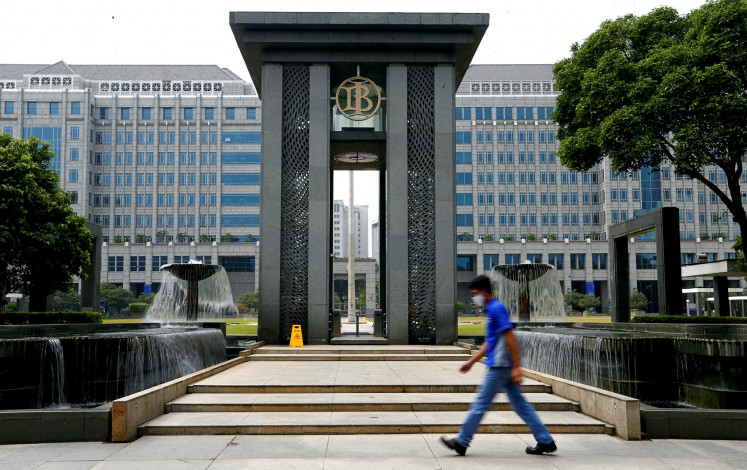Popular Reads
Top Results
Can't find what you're looking for?
View all search resultsPopular Reads
Top Results
Can't find what you're looking for?
View all search resultsMedical treatment for back and neck pain
After headaches, back pain — especially in the lower part of the back — is the most common and intractable physical ailment
Change text size
Gift Premium Articles
to Anyone
After headaches, back pain — especially in the lower part of the back — is the most common and intractable physical ailment.
It is estimated that eight out of 10 people suffer from back pain, with up to 50 percent will experience more than one episode.
This common affliction has huge implications for society including a decrease in work productivity and high health care costs.
Back pain can affect almost every one: people of all professions, males and females, young and old.
No one but sufferers can truly comprehend the complete sense of helplessness and anguish felt from this devastating condition.
The sufferer’s world shrinks – the once vigorous person is suddenly impaired, confined to home.
Activities such as sitting and walking can be agony. Brushing teeth, eating or sneezing and coughing can be torturous.
Sex becomes virtually impossible. Even after pain subsides, sufferers wonder when the pain will strike again — the horror stories are plentiful.
Neck pain is almost as common as lower-back pain. The neck is very sensitive to pain. Because it is quite mobile and joins a relatively heavy head to an inflexible chest area, it is subject to carrying degrees of trauma. To hapless sufferers, the quest for help may be as exasperating as the pain itself. Too often, specialists provide different diagnosis, more vexing.
Some causes of back pain include extrinsic factors such as heavy physical labor, frequent lifting heavy objects, sedentary office work and smoking.
Intrinsic factors such as spinal abnormalities, obesity and height are also risk factors. When you consult doctors, they will ask for a thorough medical history, give you a physical and neurological examination. This is to exclude more ominous causes such as cancer or spine fractures. Depending on the result, laboratory or radiological tests may be required.
The most common cause of back and neck pain is myofascial. Muscle strains due to overuse, for example, from sporting injuries or heavy lifting. Whiplash injuries from motor vehicle accidents are also a common cause of neck pain.
One common cause is spinal spondylosis. This condition involves spinal disc damage, which cushions the vertebrae bones. This leads to disc degeneration and hardening with subsequent new bone formation, which may lead to pressure on the nerves exiting from the spinal cord, continuing to the limbs.
The spinal cord itself may also be compressed. If severe, this may lead to numbness and weakness of the limbs. Facet joint disease, the degeneration and inflammation of the facet joints that connects one vertebra to another, is another source of neck and back pain, and so is scoliosis, an inborn curvature of the spine.
Less common causes include infection of the vertebra, for example, tuberculosis and abscess formation can also cause lower-back pain. Back pain may also be the consequence of tumors; usually metastatic, from breast, prostate, lung, kidney or thyroid cancer. Rheumatoid arthritic patients may also suffer from back pain.
Medical treatments for back and neck pain runs from conservative to invasive. Therapies included
the use of soft cervical collars or lumbar support.
Physiotherapy is undertaken in conjunction with therapeutic massage, ultrasounds, ice and heat therapy and traction, especially for neck aches.
Anti-inflammatories such as non-steroidal anti-inflammatory medication, for example aspirin, ibuprofen, naproxen, celecoxib and etoricoxib, are often used in this respect.
If conservative treatment fails, more invasive measures such as myofascial trigger-point injections, facet-joint injections, nerve blocks and steroid injections can provide relief.
Nucleoplasty involves x-ray-guided probes that are placed into bulging discs, removing excess
disc material.
IntraDiscal Electrothermal Therapy (IDET) uses thermal energy via a needle that is inserted into the offending disc and heated to a high temperature for up to 20 minutes. The heat thickens and seals the disc wall, reducing inner disc bulge and irritation of the spinal nerve.
Radiofrequency ablation of nerves to the facet joints also helps alleviate pain from facet-joint inflammation. Other treatment includes surgical procedures such as spinal fusion, laminectomy and artificial disc replacements, which are used for severe intractable spinal disease.
It is thought that exercise and an all-round healthy lifestyle is the best prevention for back and neck pain. This is not necessarily true. In fact, several studies have found that the wrong type of exercise, such as high-impact activities, may increase the chance of back pain.
Nevertheless, exercise is important for overall health. Low-impact activities such as swimming, walking and cycling can increase overall fitness and strength, without straining the low back.
©FlyFreeForHealth2010
Articles in this column, which appear every two weeks, are provided by a panel of doctors from www.flyfreeforhealth.com, a leading multimedia medical tourism platform dedicated to
providing a healthy lifestyle. The doctors include Dr Charles Siow, consultant neurologist and pain specialist, International Neuro Associates at Novena Medical Center, Singapore. Join the free online seminar “Alcohol in Pregnancy” on Jan. 12, 2010. SMS your email address to +65 98473224 to receive the link invite. Email us at info@flyfreeforhealth.com.










